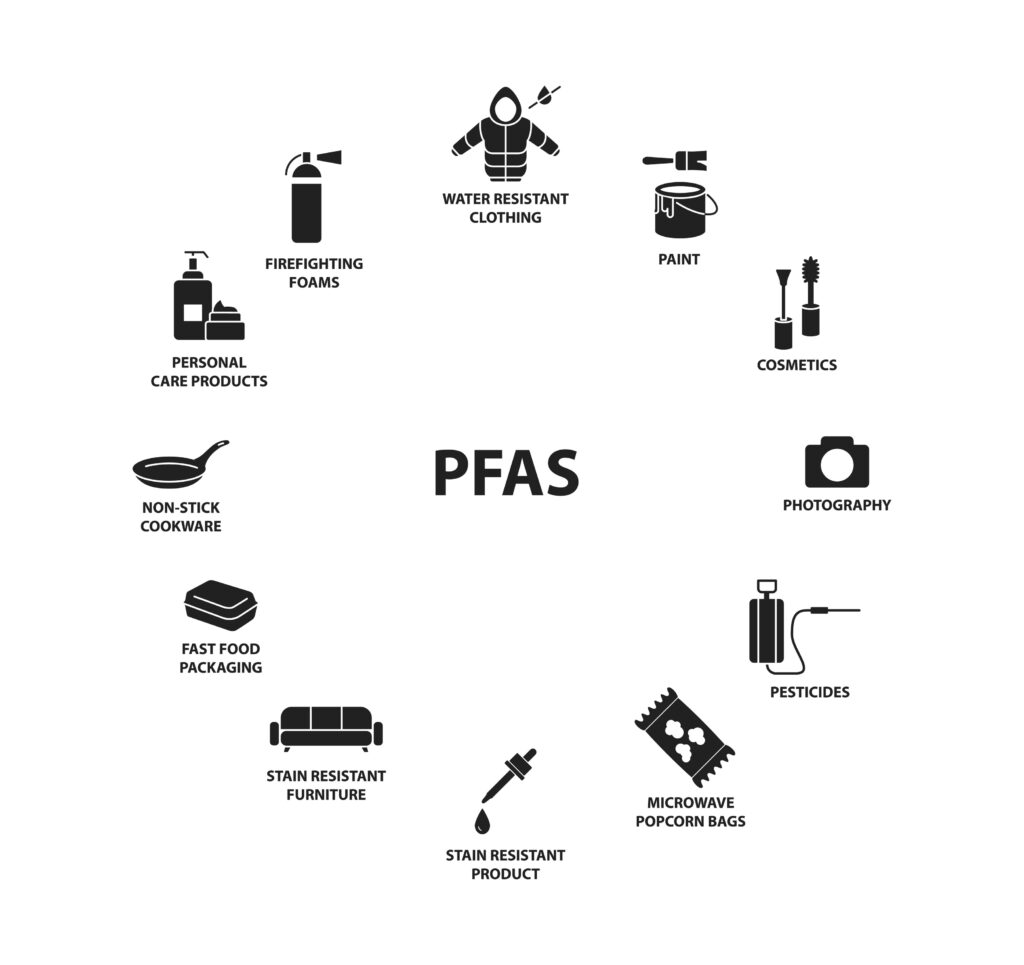Insight Paper March 7, 2024
Introduction
A brief insight into PFAS chemicals amid a rise in public and private interest.
Over the last several months and years, the public, manufacturers, and the press have all turned their attention to Per- and Polyfluoroalkyl Substances (PFAS), a near-ubiquitous manmade chemical previously thought to cause little to no harm to humans and the environment. Recently, however, our understanding of this chemical class and its manifold impacts have changed. Following the uncovering and release of new information regarding PFAS’ safety and use, costly settlements have been reached with major consumer and industrial manufacturers.1 In this Trexin Insight Paper, the first in a series on PFAS chemicals, Trexin will provide a brief overview of what the chemicals are, how they work, and, ultimately, what might be expected from regulators moving forward.
WHAT ARE PFAS?
Another significant property of PFAS is their bonds. Many of the bonds in PFAS chemicals are between atoms of carbon and fluorine. Bonds between these two atoms are extremely difficult to break because fluorine is an element that strongly seeks electrons, while carbon has them in excess causing it to pair well with elements lacking them.5 Due to these strong bonds, PFAS chemicals don’t break down naturally thus garnering the nickname, “forever chemicals”. According to the Wisconsin Department of Natural Resources, PFAS can enter and remain in waterways, air, soil, and various wildlife for incredibly long periods of time.6 Their natural durability then allows them to make their way from these sources into human bodies if they are not disposed of or handled properly.7 PFAS are also widely used in manufacturing from cookware to plastics and can enter the body through usage of or contact with these products.
A non-comprehensive list of products that may contain PFAS is listed below.

HOW DO PFAS ENTER THE BODY?
Once inside the body, PFAS can start causing troubles. PFAS are related to a variety of health problems including the increased risk of some cancers and diabetes.89 New research suggests that PFAS cause these issues as their structure is like that of fatty acids in humans which are responsible for “biological activities that act to influence cell and tissue metabolism, function, and responsiveness to hormonal and other signal” according to Philip Colder, a professor of natural immunology at the University of Southampton.10 PFAS’ ability to mimic fatty acids then results in disruptions to our biological responses such as hormone production and reaction to stimuli which, in turn, can compound into larger health difficulties.11
WHAT ARE REGULATORS DOING IN RESPONSE TO PFAS?
In 2023, 3M, one of the world’s top producers of PFAS, was struck with a $10.3 billion penalty for their contamination of public drinking water with the chemicals.1213 Following this lawsuit, the EPA issued a rule under Section 8(a)(7) of the Toxic Substances Control Act stating that “entities, including small entities, that have manufactured (including imported) PFAS in any year since 2011 will have 18 months following the effective date of this rule to report PFAS data to EPA.”14 In plain English, the deadline for reporting will be May 2025 (November of 2025 for small entities, which were given 24 months to report, rather than 18). The US isn’t the only place imposing regulations on PFAS manufacturing, however. Several European countries, for example, are examining the prospect of outright banning the manufacturing of PFAS.15 In response to this news and penalty, 3M has since declared that it will totally halt their manufacturing of PFAS by the end of 2025.16
CONCLUSION
Interest in PFAS has been renewed in light of the 3M lawsuit, and regulations appear to be mounting fast. Trexin has direct experience working with Clients who either have or want to inspect their supply lines for the substance. Our Advisors have the experience and expertise to tackle any PFAS related concern your organization might have while working quickly and efficiently within the bounds of new regulations. To learn more about Trexin’s work with PFAS and how we can help you, click here:
REFERENCES
- https://www.reuters.com/legal/government/us-states-withdraw-objections-3ms-103-billion-pfas-settlement-2023-08-29/
- https://www.niehs.nih.gov/health/topics/agents/pfc
- https://www.atsdr.cdc.gov/pfas/docs/PFAS_FamilyTree_EnvHealthPro-508.pdf
- https://www.ncbi.nlm.nih.gov/pmc/articles/PMC7433796/
- https://news.northwestern.edu/stories/2022/08/forever-chemicals-destroyed-by-simple-new-method/
- https://dnr.wisconsin.gov/topic/PFAS/Impacts.html
- https://www.wbur.org/news/2019/11/08/what-are-pfas-chemicals-and-should-i-be-freaking-out-about-them
- https://www.pfas.des.nh.gov/health-impacts
- https://www.nature.com/articles/s41370-023-00529-x#:~:text=Per%2D%20and%20polyfluoroalkyl%20substances
- https://pubmed.ncbi.nlm.nih.gov/26177664/
- https://www.endocrine.org/topics/edc/what-edcs-are/common-edcs/pfas#:~:text=PFAS%20chemicals%20can%20affect%20our,can%20cause%20adverse%20health%20effects
- https://www.ucsf.edu/news/2023/05/425451/makers-pfas-forever-chemicals-covered-dangers#:~:text=A%20new%20paper%20published%20May,delay%20regulations%20governing%20their%20use
- https://apnews.com/article/pfas-forever-chemicals-3m-drinking-water-81775af23d6aeae63533796b1a1d2cdb
- TSCA Section 8(a)(7) Reporting and Recordkeeping Requirements for Perfluoroalkyl and Polyfluoroalkyl Substances | US EPA
- https://cen.acs.org/policy/chemical-regulation/battle-over-PFAS-Europe/101/i31
- https://pfas.3m.com/pfas_uses#:~:text=3M%20will%3A,obligations%20during%20the%20transition%20period


